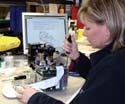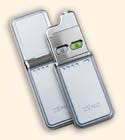April 5, 2005
Originally Published MPMN April 2005
Special Section
Electronics Outsourcing: When the Connection Is Made
Collaboration, communication with electronics manufacturing service firms pay off for medical OEMs
Sidebar: |
The motivation for medical device manufacturers to use contract manufacturing has grown in recent years. Old concerns about costs, skill levels, and intellectual property protection have disappeared. In their place is a renewed focus on core competencies by the OEMs, allowing them to hand over the reins to experienced contractors with successful track records.
Electronics manufacturing service (EMS) firms are expanding to better serve device OEMs. As the OEMs get more comfortable with the quality of the services provided, the contractors’ involvement in all stages of the development process will increase.
Smaller, Better, Faster, More
|
Minnetronix specializes in the design and manufacture of custom embedded software and electronics for the medical device industry. |
Medical electronics have changed in several ways over the last decade. As electronics technology has advanced, the actual incorporation of the electronics into medical devices has advanced as well.
Miniaturization has played a key role, from shrinking the circuitry inside the devices to the outer packaging. The integration of electrical and mechanical parts has also brought down the size of devices, according to Richard Nazarian, president of Minnetronix (St. Paul, MN; www.minnetronix.com). “Current trends are leading away from the use of large-scale circuit boards and more toward seamless products with electronics woven into the device,” he adds. In effect, electronics manufacturers are now “thinking outside the box,” in that medical devices are being made with the electronics inside the device itself, rather than inside the units (or “boxes”) located next to the device.
Data collection and storage are also of paramount importance. Medical devices that track and store data must now be equipped with memory systems that are not only secured against inappropriate access, but also from environmental elements that may damage memory, says general manager and vice president of engineering Hal Kent of Medconx (Santa Clara, CA; www.medconx.com). “Some sterilization techniques will wipe out a device’s memory, so we’ve had to develop ways to fix that.”
|
The circuit board (top) and motherboard shown here are manufactured by Nexlogic for use in medical devices such |
A stronger focus on the development of medical devices for ambulatory and consumer use is also being seen. The electronics within these devices are being used not only for purposes of analysis but also for communication, such as RF-signal-equipped glucose meters for wireless transmission of blood sugar levels to a remote central database for analysis. Such devices are not only easy for patients to use, says Zulki Khan, president of Nexlogic (San Jose, CA; www.nexlogic.com), “but are much more accurate because [the device] isn’t relying on the patient to determine the results.”
“It’s All About Relationships”
Interactions between medical OEMs and EMS providers have dramatically shifted over the past few years. Once unable or unwilling to allow outside contractors to work on product development, the OEMs are opening up to the opportunities offered by collaborating with the EMS industry. “Just having an OEM consider a contract manufacturer for its product is one of the biggest changes,” says Greg Love, CEO of Micro Power (Hillsboro, OR; www.micro-power.com) of the paradigm shift. In days of yore, major medical manufacturers would use internal talent to build products, or hire personnel for specific projects. Developing projects internally meant a longer time to market—in some cases, five to seven years, says Love.
|
Micro Power, a supplier of power systems for portable medical equipment, has developed the battery system shown above for use with a portable ultrasound device. |
As costs grew more prohibitive and OEMs were forced to scale back resources, more possibilities for contract work opened up for electronics manufacturers. And, as the electronics manufacturers began to build their capabilities and establish themselves as experts, the OEMs became much more comfortable with using their services.
“The standard belief was that OEMs knew their product best, and that they had the best resources for developing and manufacturing products,” says Khan. “Now OEMs are going back to focusing on core competencies, such as product development, and are now relying on a single source for manufacturing. It’s all about building the relationships.” Such reliance requires effective communication and cooperation between OEMs and contract manufacturers.
The relationship-building process has evolved into OEMs asking for the contractor’s involvement in all phases of the production cycle, from concept to final assembly—which is just fine with many EMS providers. “Our early objective is to participate with our customers when the product is being defined,” says Rob Weyer, director of business development at Three-Five Systems (TFS; Redmond, WA; www.tfsc.com).
Device OEMs now view some EMS providers as consultants in specialized areas. “We’re assisting the R&D teams in designing prototypes that incorporate more electronics by providing them with our expertisein electronic interconnects,” says Medconx’s Kent. Such collaborative engineering, as Kent calls it, ends up being a value-added service for many EMS companies.
All Offshore That’s Going Offshore…
|
The Smart Block from MedConx interconnects and terminates fine wires in handheld electromedical devices. |
Contract manufacturing has been done in overseas markets for many years. Low labor costs have made it highly desirable for companies to take advantage of Asian outsourcing. Yet for the medical device manufacturing industry, debates have raged over such issues as the quality of the finished product, materials management, and meeting international standards.
One key factor that keeps many medical OEMs from using offshore outsourcing is that of volume. Many Asian companies only accept high-volume, low-yield orders, hence the influx of consumer electronics that are produced in Hong Kong, Taiwan, and the like. Yet OEMs that are producing electronic medical devices typically need low-volume, high-yield goods.
Khan believes that products requiring extensive testing may benefit from U.S.-based manufacturing. As more medical electronics are created for consumer use, such as patient monitors, it’s highly likely that more products will be sent overseas for contract manufacturing, suggests Weyer.
Another issue is materials management. Costs of shipping components back and forth can get quite high. “If you want to make FedEx and DHL happy, outsource overseas,” jokes Kent. “The reality is that if the product design gets revised or there’s a quality defect, everything has to be air shipped.” Additionally, products that are still being fine-tuned by design and engineering teams may be more difficult to manage if sent offshore, says Nazarian.
Probably the most challenging problem by far is dealing with regulatory issues. While some U.S. electronics manufacturers establish foreign subsidiaries (see sidebar), others must deal with the paperwork involved in getting a foreign-made product to meet U.S. quality standards, as well as U.S. FDA requirements. “There’s a tremendous benefit to manufacturing in the United States under the OEM’s FDA registration,” states Love. With medical devices, traceability, documentation, and process validation need to be in place in order to do business in the United States “If you don’t have the required process and procedures, the FDA auditor could shut you down,” he adds.
The Wave(s) of the Future
Going forward, medical electronics outsourcing will most likely change in ways that will resolve current problems. Issues with quality control may lead to more internalized quality systems that comply with federal regulations, as well as with international standards. “Selecting a full-service contract manufacturer with a good quality system seems to be the answer for medical OEMs,” says Khan. Love suggests that as more medical manufacturers begin outsourcing electronics to Asia, additional resources for establishing and monitoring FDA regulations in Asia may be needed.
EMS providers may also move away from a modular approach to manufacturing and become more turnkey. This paradigm shift would require contract manufacturers to add services, such as product testing and engineering, rather than relying on the OEMs, or possibly subcontractors, to supply these services. As Weyer reports, more and more design firms are merging with or being acquired by EMS companies.
|
A Class 2 medical device for therapeutic skin care is manufactured by Three-Five Systems (TFS). |
Personnel that have backgrounds in more than one aspect of manufacturing are also highly desirable, he adds. “A growing trend in recruitment at TFS is to hire engineers that have R&D experience.” Becoming turnkey gives EMS firms the prospect of not only developing the products, but also sustaining them when changes are made.
“Having the design and manufacturing done by the same company can often get you to market faster,” says Nazarian. “Knowing how everything will flow together and having development systems that facilitate this requires a shift in mind-set.” This also affords OEMs the opportunity to focus on their core competencies of development work, rather than focusing on the manufacturing of the products, adds Kent.
Offshore outsourcing will continue to grow. “The Asian market is hungry for medical,” says Weyer. “It may not be what most manufacturers consider high volume or high revenue, but it’s steady and predictable work.” He suggests that transferring products to offshore manufacturers can be done successfully once the product design is stable. As confidence levels in offshore outsourcing increase, more midlevel to large EMS providers may open facilities in Asia, while smaller EMS organizations may partner with firms that have offshore operations in order to cut costs.
Lastly, more collaboration, communication, and coordination will be needed between medical electronics manufacturers and the medical OEMs that hire them. Selecting an EMS firm requires OEMs to carefully consider the company’s track record as well as its capabilities. Setting clear boundaries, recognizing successes, and effectively managing crises will make for stronger bonds between contractors and OEMs, states Khan. “Investing in the relationship is the key.”
Copyright ©2005 Medical Product Manufacturing News
You May Also Like







